(完整版)高中英语优质课全英教案
高中英语教案英文版5篇
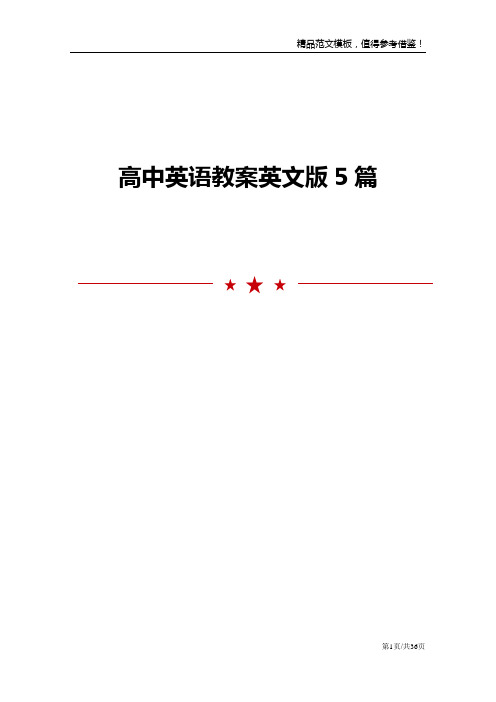
高中英语教案英文版5篇高中英语教案英文版5篇教案可以恰当地选择和运用教学方法,调动学生学习的积极性,面向大多数学生,同时注意培养优秀生和提高后进生,使全体学生都得到发展。
以下是带来的内容,感谢您的阅读,希望能帮助到您!高中英语教案英文版1Teaching Procedures of Period 1:Step1.Warming up (15 mins)Ss know a lot about sports from everyday life and media, so I arrange sucha task -discussion(group of 4): Q: What do you know about sports?During this process, if Ss can’t express themselves in English, Chinese isalso all right. Besides, it is agood chance to present new words. If necessary, I will make somecomplements. At the same time, I will present them as many pictures about sportsas possible.Possible response:school sports meetSports meet the National Gamesthe Asian Gamesthe Olympic Gamesthe World Cupetcball games: volleyball, basket ball, football, table tennis, tennis,,golfbadminton, bowling, baseball, American football, ice hockey etcEvents of sports track and field: relay race, long jump, high jump, polejump, discus, shot, javelin etcgymnastic: rings, double bars, high and low bars, horse , free exerciseswimming/shooting/skiing/ ice sports/diving/aquatic sports etcSport stars : Beckham, Mike Owen, Michael Jordan etc Purpose: This activity is designed to encourage students to think aboutsports and activaterelevant vocabulary.Step 2. Speaking(15 mins)Task1(pair work): Talk about their favourite sports, favourite sportsstars, and the reason why they like them, with the following expressions as aguide.(See SB p52) Task2(pair work): A survey about physical fitness (Seepostscript 1)Task3(group work): Add up their total scores and divide by the number ofpeople. Then get their group’s average scores. Discuss their survey answers.1). Do you think your group is doing well or not? Why ?2). How can you become fitter?高中英语教案英文版2教学目标Teaching aims and demands本单元的教学目标是使学生掌握表示判断和个人看法的常用语句,学会使用现在完成时的被动语态。
英语公开课优质教案高中英语优质公开课教案(五篇)
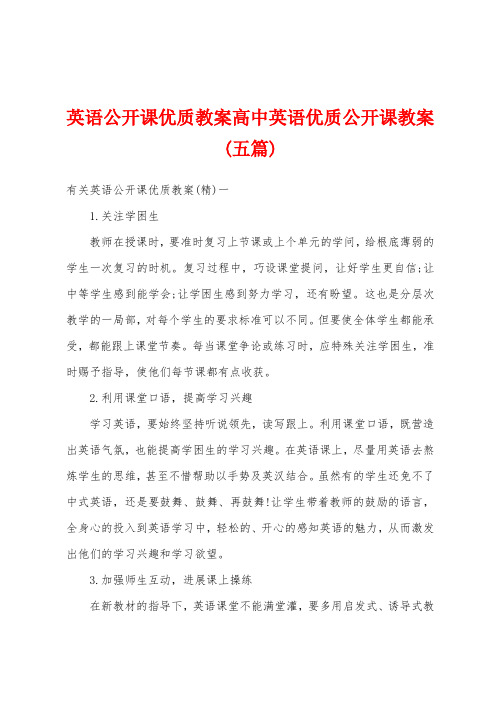
英语公开课优质教案高中英语优质公开课教案(五篇)有关英语公开课优质教案(精)一1.关注学困生教师在授课时,要准时复习上节课或上个单元的学问,给根底薄弱的学生一次复习的时机。
复习过程中,巧设课堂提问,让好学生更自信;让中等学生感到能学会;让学困生感到努力学习,还有盼望。
这也是分层次教学的一局部,对每个学生的要求标准可以不同。
但要使全体学生都能承受,都能跟上课堂节奏。
每当课堂争论或练习时,应特殊关注学困生,准时赐予指导,使他们每节课都有点收获。
2.利用课堂口语,提高学习兴趣学习英语,要始终坚持听说领先,读写跟上。
利用课堂口语,既营造出英语气氛,也能提高学困生的学习兴趣。
在英语课上,尽量用英语去熬炼学生的思维,甚至不惜帮助以手势及英汉结合。
虽然有的学生还免不了中式英语,还是要鼓舞、鼓舞、再鼓舞!让学生带着教师的鼓励的语言,全身心的投入到英语学习中,轻松的、开心的感知英语的魅力,从而激发出他们的学习兴趣和学习欲望。
3.加强师生互动,进展课上操练在新教材的指导下,英语课堂不能满堂灌,要多用启发式、诱导式教学方法。
例如,教授单词时,重点单词和句型应多操练,举出各种典型例句,和生活性强的例句,让学生充分参加。
在反复操练中,兼顾那些学困生,让他们也获得胜利的体验,这样,有效地增加了课堂分散力。
4.增加课前预习和课后复习环节课前预习,对于上课起到很好的促进作用,是打造英语高校课堂不行或缺的环节。
布置可课下作业时,最好分成学习小组,利用早、晚阅读时间,小组长可以起到催促和检查的作用。
固然,课上导入和复习也是检查的重要一环。
学生回答下列问题时,多鼓舞,少批判,给学生留点自尊,也就给他们留下了学习的士气。
总之,只有全班学生融入到英语学习大课堂中,才算是真正的英语高校课堂。
让全部的英语教师为英语高校课堂而努力吧!有关英语公开课优质教案(精)二敬重的大方的漂亮的得意而心地和善的英语教师:你好!在这样一个悲凉的日子里,我怀着内疚的惭愧的心情写下了这封信,不但检讨自己,更是为了渴望你的原谅。
优质高中英语教学设计5篇

优质高中英语教学设计5篇作为一无名无私奉献的教育工作者,总不可避免地需要编写教学设计,教学设计有利于教学水平的提高,有助于教研活动的开展。
那么教学设计应该怎么写才合适呢?以下是小编收集整理的优质高中英语教学设计,欢迎阅读,希望大家能够喜欢。
优质高中英语教学设计1一、教材分析:本课是结合人教版高中英语教材选修5中有关过去分词的语法内容,进行过去分词的学习,教学中将语法知识的传授和语言基本技能的学习结合到一起,注重复习语法与语言的运用。
采用任务型教学法和小组合作探究学习法,从而扩大课堂的语言输入量及学生的语言输出量。
二、学情分析:在高一英语学习基础上,学生已经掌握基本的语言结构和一定程度的听说读写能力。
在复习的过程中,结合学生原有的知识掌握水平,巩固基础强化正确使用语法知识,提高学生运用语言的深度和难度.但大部分学生的基础知识仍然较为薄弱,运用英语进行交际活动的能力较差,主动学习的动力不够,然而他们学习比较认真,渴求知欲旺盛,思维比较活跃。
部分学生的基础较好,能主动配合老师。
只有设置使他们感兴趣的活动,因材施教,才能让他们投入到课堂活动中来。
三、教学目标:1.知识目标:引导学生掌握过去分词在真实的生活语境中的使用。
培养学生通读,分析,理解,综合的能力,教会学生体察语境,结合上下文,符和逻辑推理和合理的想象,结合语法和题干中的语境解决问题。
在运用语言过程中培养学生的观察力、分析力、想象力和自学能力,提高思维能力和运用英语的综合能力。
2.能力目标:利用多媒体手段营造积极和谐教学氛围,使学生进入情景之中,充分调动学生的思维活动和情感体验,规范学生运用英语知识准确表达的能力,同时,发展学生综合语言运用的能力,分析问题和解决问题的能力,培养学生自主学习。
3.德育目标:用含过去分词的句子结构表达思想感情。
四、教学重点:1.过去分词的用法.2. 过去分词的运用五、教学难点:1.结合语法知识,以课堂教学为依托,全面训练学生的听、说、读、写能力,加强和提高运用英语的综合能力。
高一英语全英教案5篇

高一英语全英教案5篇高一英语全英教案篇1教学目标1. 语言知识目标:1) 能掌握以下单词:rules, arrive, late, hall, dinning hall, listen, listen to, fight, sorry2) 能掌握以下句型:①Don't eat in class.②You must be on time.③Eat in the dining hall.2. 学会用英语表达一些标志的含义。
3. 熟练使用目标语言谈论对某些规章制度(校规、家规等)的看法3. 情感态度价值观目标:能用英语表达和制定一些简单的规则,理解没有规矩不成方圆;无论是在学校时还是在家庭中以及以后走上社会都应当遵守规则,按规则办事。
教学重难点1. 教学重点:1) 肯定祈使句是省略掉主语的原形动词开头;2) 否定祈使句则是在肯定祈使句前加上“don’t”。
3) 情态动词must及have to在用法上的区别。
2. 教学难点:掌握祈使句的用法,并能听懂、会说一些简单的祈使句。
多媒体教学过程Ⅰ. Warming-up and revision教师进教室后,使用祈使句请学生们完成一系列动作:Please stand up/ sit down. Close the door, please. Look at me and listen to me.Don’t open your books. Don’t talk. Let’s begin our class.学生听教师的指令完成各种动作,教师也可将指令写到黑板上,让学生从视觉上考察祈使句的特点。
Ⅱ. Presentation教师出示书上1a 的图片,向学生提问。
指着图上奔跑的男孩提问T:What’s the boy doing? S: He’s running.T: Where is he running? S: He’s running in the hallways.(板书,教读)T:Can you run in the hallways? S: No, I can’t.T: So please don’t run in the hallways.(板书,教读)(= You can’t run in the hallways.)学生跟读数遍,明白祈使句和“can”的表达含意。
高中英语教案全英文版
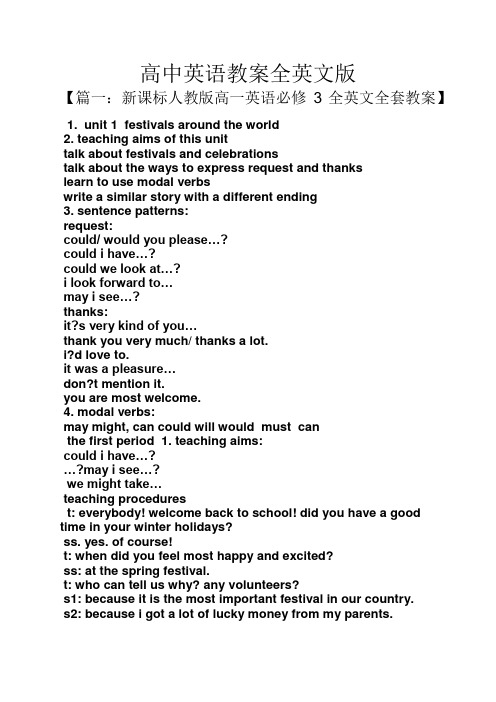
高中英语教案全英文版【篇一:新课标人教版高一英语必修3全英文全套教案】1. unit 1 festivals around the world2. teaching aims of this unittalk about festivals and celebrationstalk about the ways to express request and thankslearn to use modal verbswrite a similar story with a different ending3. sentence patterns:request:could/ would you please…?could i have…?could we look at…?i look forward to…may i see…?thanks:it?s very kind of you…thank you very much/ thanks a lot.i?d love to.it was a pleasure…don?t mention it.you are most welcome.4. modal verbs:may might, can could will would must canthe first period 1. teaching aims:could i have…?…?may i see…?we might take…teaching procedurest: everybody! welcome back to school! did you have a good time in your winter holidays?ss. yes. of course!t: when did you feel most happy and excited?ss: at the spring festival.t: who can tell us why? any volunteers?s1: because it is the most important festival in our country.s2: because i got a lot of lucky money from my parents.s3: because i needn?t study at festivals and there was a lot of delicious food to eat.how great.s4: because i met my cousins and friends who i hadn?t seen for a long time.t. very food! i am glad to hear that. today we will talk about festivals, which aremeant to celebrate important events. please think about some other festivals. can you name just a few?ss: new year, yuan xiao festival…:t: quite right. that?s called the lantern?s festival. how about some otherfestivals?ss: the army day, international labour?s day, national day, tomb sweepingfestival, dragon boat festival, mid-autumn day…t: you have done a good job, boys and girls! .step Ⅱwarming –uplike best---the music, the things to see, the visits or the food? step Ⅳassignment1. consolidation2. listening to the material again after class to be familiar with it.3. homework: collect as much information about festivals as possible.the second period readingteaching aims1.vocabulary: starve, starvation, plenty, satisfy ancestor lamps lead feast bone originin memory of dress up trick poet arrival national gain independencegather agricultural european custom awards watermelon handsomerooster admire look forward to religious as though have fun with daily2.to enable the students to know the earliest festivals with reasons for them and four different kinds of festivals that occur in most parts of the world3.to enable the students to master some english expressions and phrases festivals.4. teach the basic reading skills: skimming and scanning.5. try to compare and make conclusion s of different festivals. step Ⅰrevision1. greetings.2. review the new words of this part.3. check the students? homework---festivalsstep Ⅱreading1.scanning( four minutes later, with the whole class. show the suggested ( allow to read aloud and carefully this time to understand the main3.reading and discussiont: read the text a third time and then work impairs to do exercise 2 on page 3.( let the students have enough time to read the passage carefully and discuss the chart with their partners. encourage them to expand their answers according to their own experiences.)4.explanation(in this part try to help the students analyse the difficult, long and complex sentences and guess the meaning of the new words; ask them to deal with the language points in the context.)t: now i will discuss some important sentences and phrases in the passage.a. some festivals are held to honor the dead, or satisfy and please the ancestors,who could return either to help or to do harm.b. in memory ofc. the leader who helped gain india?s independence from britain.d. a season of agricultural work is over.e. the end of winter and to the coming of spring.f. be covered with pink snow.the suggested explanation:a. an attributive clause.dead or to make happy in case they might come back to do harm.b.(hoping)(defending)c. →energetic adj. ( full of or done with energy)look forward to ( to is a preposition here.)devote to, be/get used to, get down to , stick toe.g. i?m looking forward to hearing from you.step Ⅲ listeningt: now i will play the tape for you. you can just listen with your books closed or look at your books or read in a low voice together with the tape. it?s up to you. after listening, please write down three things that most festivals seem to have incommon.( comprehending ex.3 on page 3).the third period learning about languageteaching aims:1. let the students know the usage of modal verbs.2. enable the students to recognize the words and expressions in the reading passageaccording to what mean the same as them.step Ⅰ greeting and revision( ask some students to retell the text we learned .)stepⅡ. practicing the useful words and expressionst: as we know, there are two important kinds of and intransitive verbs. but many intransitive verbs structure on.the words given.s2: we are talking about verbs.s3: would you like to talk with me?step Ⅲ verbs form and try to explain their meanings. if you have anystepthe usage of modal verbs. i think it is not easy for you to master them, after class you should review them.homework1. practice of wbp42ex.1,2,3.2. please find out10 sentences with modal verbs, and try to get their meanings.the fourth period listening【篇二:高中英语教案范例】新年第一节英语课(高一教案)step i greetings and lead in(问候以及导入)1. happy new year!t: well, i am so happy to see you again after the long vacation.i wish everyone of you had a happy holiday. so how about your holiday? had you done some travel? 2. learn someexpressions about “dragon”(学习一些关于中国龙的习语、成语)t: this year is the year of dragon, so we will play a guessing game. i will show the english expressions and you try to guess the chinese expressions, long included.step ii revision(复习)1. dear, how many words can you still remember after amonths winter holiday?2. 2. how many phrases can you still remember?3.3. do you still remember the grammar very closely?there is no shortcut in the science road ,only be deligent.在科学上没有平坦的大道,只有不畏劳苦沿着陡峭山路攀登的人,才有希望达到光辉的顶点。
最新高中英语优质课全英教案
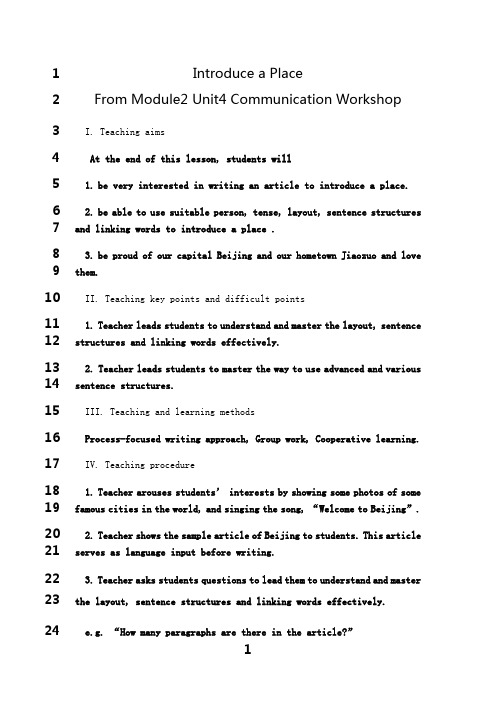
Introduce a Place1From Module2 Unit4 Communication Workshop23I. Teaching aims4At the end of this lesson, students will51.be very interested in writing an article to introduce a place.62.be able to use suitable person, tense, layout, sentence structures 7and linking words to introduce a place .83.be proud of our capital Beijing and our hometown Jiaozuo and love 9them.10II. Teaching key points and difficult points111. Teacher leads students to understand and master the layout, sentence 12structures and linking words effectively.132. Teacher leads students to master the way to use advanced and various 14sentence structures.15III. Teaching and learning methods16Process-focused writing approach, Group work, Cooperative learning.17IV. Teaching procedure181.Teacher arouses students’ interests by showing some photos of some 19famous cities in the world, and singing the song, “Welcome to Beijing”.202.Teacher shows the sample article of Beijing to students. This article 21serves as language input before writing.223. Teacher asks students questions to lead them to understand and master 23the layout, sentence structures and linking words effectively.24e.g. “How many paragraph s are there in the article?”25Answer: (1. Introduction. 2. Things to see. 3. Things to do. 4. Ending 26words.)27“What factors are in cluded in the first paragraph?”28Answer: (General description, Location, Area, Population, History, 29Climate and Temperature.).30“Can you find and circle the beautiful and advanced sentences in the 31article?”32Answer:33(Location : 1. …is located in … 2. …lies in….34Area: 1. …covers an area of… 2. ...is the second/ third/rgest 35city in the world as regards area. etc.)36374. Students work in groups and cooperate with each other to answer these 38questions.395. Teacher introduces the writing task “write an article to introduce 40Jiaozuo.416. Teacher divides students into groups of six and arouses them to 42express the photos of Jiaozuo in best possible ways according to the 43sentence structures in the article of Beijing. Meanwhile, teacher44encourages students to join simple sentences together with linking words, 45relative pronouns, present participles, etc. to form more advanced and 46more various sentence structures.477. Students write the first drafts by themselves.488. Teacher stimulates students to check and correct their own drafts;49meanwhile, teacher provides the standards of checking and correcting.50For example, the content, the layout, the language, the linking words, 51the handwriting, the tense and person, the grammar and the spelling. 529. Teacher divides students into groups of six and arouses them to check 53and correct their partners’ articles. Teacher provides the standards 54of checking and correcting again.5510. Teacher chooses two typical articles to examine before class; 56students learn how to check fully and effectively.5710. Teacher help the students to summarize some typical and common 58mistakes among students’ articles, and correct and analyze them.5912. Homework. Polish the first draft and rewrite it.60V. After-class reflection(教后反思)611. By singing a song to lead in, students are deeply aroused to read 62the sample article of Beijing, but my singing is not professional and 63perfect.642. The article is well designed with many good sentence structures and 65linking words, students can understand them by answering the questions 66intended for them, but the time spared for them is too limited, and they 67can’t fully master a nd practice them.683. The time given students to write is 10 minutes, which proves69relatively short and limited. I should have given them more time to write 70the article better.714. The time for students to check is only 3 minutes, which proves to 72be too short. The checking procedure is very important in writing practice, 73so teachers should place more emphasis on it.。
高中英语课全英教案
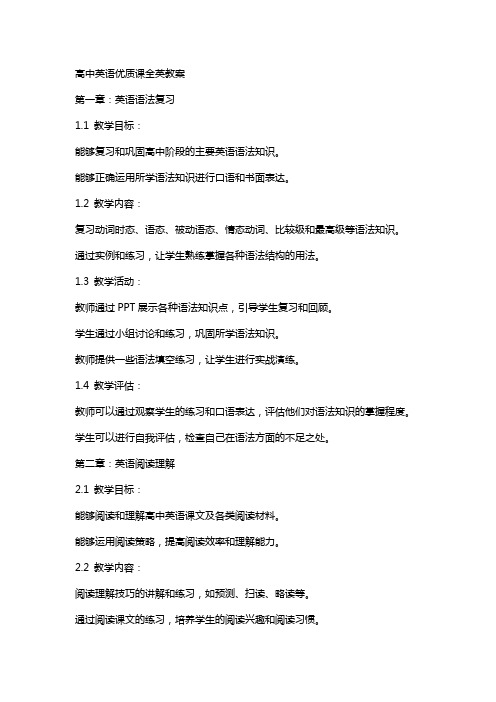
高中英语优质课全英教案第一章:英语语法复习1.1 教学目标:能够复习和巩固高中阶段的主要英语语法知识。
能够正确运用所学语法知识进行口语和书面表达。
1.2 教学内容:复习动词时态、语态、被动语态、情态动词、比较级和最高级等语法知识。
通过实例和练习,让学生熟练掌握各种语法结构的用法。
1.3 教学活动:教师通过PPT展示各种语法知识点,引导学生复习和回顾。
学生通过小组讨论和练习,巩固所学语法知识。
教师提供一些语法填空练习,让学生进行实战演练。
1.4 教学评估:教师可以通过观察学生的练习和口语表达,评估他们对语法知识的掌握程度。
学生可以进行自我评估,检查自己在语法方面的不足之处。
第二章:英语阅读理解2.1 教学目标:能够阅读和理解高中英语课文及各类阅读材料。
能够运用阅读策略,提高阅读效率和理解能力。
2.2 教学内容:阅读理解技巧的讲解和练习,如预测、扫读、略读等。
通过阅读课文的练习,培养学生的阅读兴趣和阅读习惯。
2.3 教学活动:教师引导学生进行课文阅读,讲解和分析课文内容。
学生进行阅读练习,运用所学的阅读策略。
教师提供一些阅读理解题目,让学生进行实战演练。
2.4 教学评估:教师可以通过观察学生的阅读练习和答案,评估他们的阅读理解能力。
学生可以进行自我评估,检查自己在阅读理解方面的不足之处。
第三章:英语写作技巧3.1 教学目标:能够运用所学写作技巧,写出一篇条理清晰、内容丰富的高中英语作文。
3.2 教学内容:写作技巧的讲解和练习,如组织结构、段落划分、连接词等。
通过写作练习,培养学生的写作兴趣和写作能力。
3.3 教学活动:教师讲解和示范写作技巧,引导学生进行写作练习。
学生进行写作练习,运用所学的写作技巧。
教师提供一些写作题目,让学生进行实战演练。
3.4 教学评估:教师可以通过阅读学生的作文,评估他们的写作能力。
学生可以进行自我评估,检查自己在写作方面的不足之处。
第四章:英语口语表达4.1 教学目标:能够运用所学口语表达技巧,进行流利、自然的英语口语交流。
高中英语课全英教案
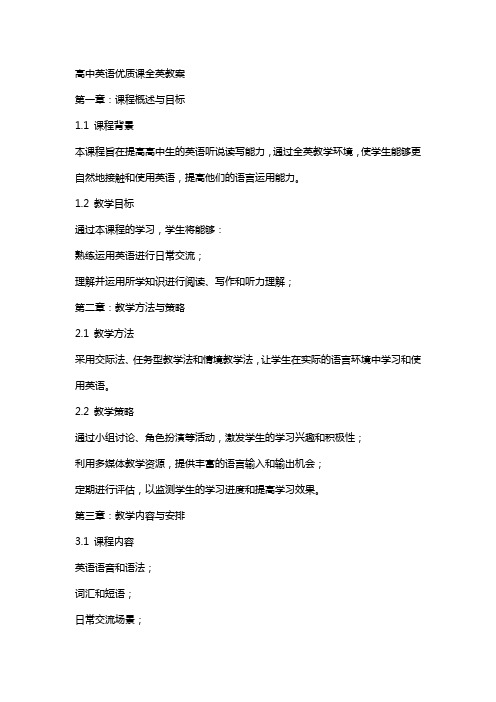
高中英语优质课全英教案第一章:课程概述与目标1.1 课程背景本课程旨在提高高中生的英语听说读写能力,通过全英教学环境,使学生能够更自然地接触和使用英语,提高他们的语言运用能力。
1.2 教学目标通过本课程的学习,学生将能够:熟练运用英语进行日常交流;理解并运用所学知识进行阅读、写作和听力理解;第二章:教学方法与策略2.1 教学方法采用交际法、任务型教学法和情境教学法,让学生在实际的语言环境中学习和使用英语。
2.2 教学策略通过小组讨论、角色扮演等活动,激发学生的学习兴趣和积极性;利用多媒体教学资源,提供丰富的语言输入和输出机会;定期进行评估,以监测学生的学习进度和提高学习效果。
第三章:教学内容与安排3.1 课程内容英语语音和语法;词汇和短语;日常交流场景;英语听说读写技能的训练。
3.2 教学安排每周安排两节全英授课,每节课时为45分钟。
课程将持续一学期,共计18周。
第四章:教学评估与反馈4.1 评估方法通过定期的测试和作业评估学生的学习成果。
测试包括听力和口语考试、笔试和课堂表现。
4.2 反馈教师将对学生的学习情况进行定期反馈,帮助学生了解自己的优点和需要改进的地方,并提供必要的辅导和支持。
第五章:教学资源与材料5.1 教学资源英语教材和辅助材料;多媒体教学设备;网络资源和学习平台。
5.2 学生材料英语词典;学习笔记和练习册;个人电脑或平板电脑,用于在线学习和作业提交。
第六章:课堂管理6.1 纪律与规则建立积极的课堂氛围,鼓励学生积极参与;准时开始和结束课程,遵守课堂纪律;尊重学生,确保教学活动有序进行。
6.2 学生参与鼓励学生提问和发表意见;组织小组讨论和角色扮演等活动,提高学生的参与度;根据学生的兴趣和水平,设计合适的教学活动。
第七章:作业与练习7.1 作业布置布置与课堂内容相关的作业,巩固所学知识;作业难度适中,给予学生一定的挑战;设定作业提交截止时间,并按时批改。
7.2 练习设计在课堂上进行听力、口语、阅读和写作练习;利用多媒体教学资源,提供实时的练习和反馈;鼓励学生自主学习,进行课外阅读和听力训练。
高中英语优秀教学案例六篇
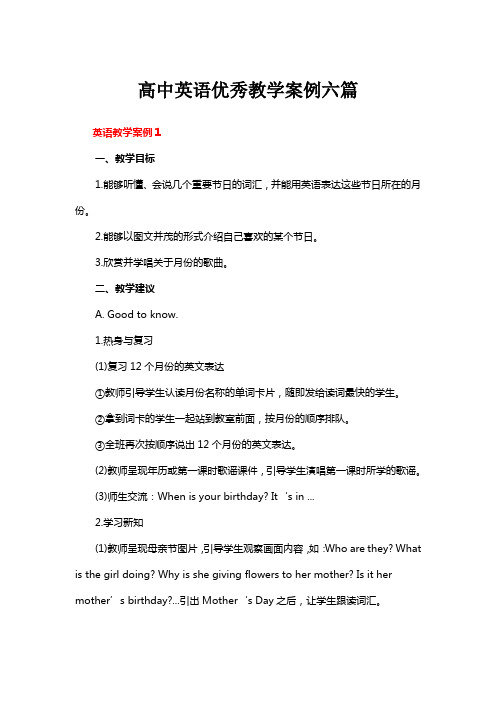
高中英语优秀教学案例六篇英语教学案例1一、教学目标1.能够听懂、会说几个重要节日的词汇,并能用英语表达这些节日所在的月份。
2.能够以图文并茂的形式介绍自己喜欢的某个节日。
3.欣赏并学唱关于月份的歌曲。
二、教学建议A. Good to know.1.热身与复习(1)复习12个月份的英文表达①教师引导学生认读月份名称的单词卡片,随即发给读词最快的学生。
②拿到词卡的学生一起站到教室前面,按月份的顺序排队。
③全班再次按顺序说出12个月份的英文表达。
(2)教师呈现年历或第一课时歌谣课件,引导学生演唱第一课时所学的歌谣。
(3)师生交流:When is your birthday? It‘s in ...2.学习新知(1)教师呈现母亲节图片,引导学生观察画面内容,如:Who are they? What is the girl doing? Why is she giving flowers to her mother? Is it her mother’s birthday?...引出Mother‘s Day之后,让学生跟读词汇。
英语教学案例2一、语言技能目标第一层次:1.能够听懂、会说衣服词汇cap,coat,shoes,sweater,jacket,gloves,trousers;能在四线三格中基本规范地抄写单词,并尝试借助拼读规律记忆单词。
2.能够听懂、会说用来介绍复数衣服的功能句:These are ...3.能够听懂、会说用来询问自己该穿什么衣服的功能句:What should I wear today?及其答语:You should wear ...,初步学会在恰当的情境中运用,并通过描摹句子来体会句子书写规范,为抄写句子和独立写句子打基础。
4.能够读懂介绍自己所在城市的季节、天气、穿衣情况以及询问对方城市相关情况的小书信;并通过替换小书信中的关键信息回信,介绍自己的上述情况,回复朋友的询问。
5.能够借助熟悉的旧单词和图片感知字母u在闭音节单词中的发音规律,并利用该规律拼出新单词的读音,进而尝试记住其写法。
高中英语课全英教案
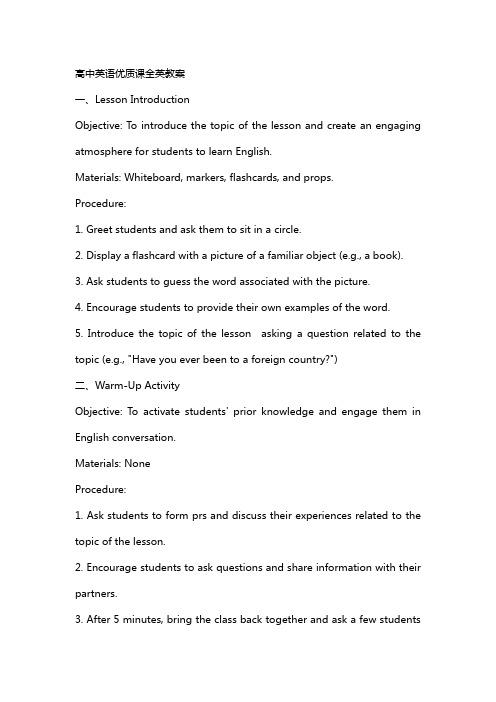
高中英语优质课全英教案一、Lesson IntroductionObjective: To introduce the topic of the lesson and create an engaging atmosphere for students to learn English.Materials: Whiteboard, markers, flashcards, and props.Procedure:1. Greet students and ask them to sit in a circle.2. Display a flashcard with a picture of a familiar object (e.g., a book).3. Ask students to guess the word associated with the picture.4. Encourage students to provide their own examples of the word.5. Introduce the topic of the lesson asking a question related to the topic (e.g., "Have you ever been to a foreign country?")二、Warm-Up ActivityObjective: To activate students' prior knowledge and engage them in English conversation.Materials: NoneProcedure:1. Ask students to form prs and discuss their experiences related to the topic of the lesson.2. Encourage students to ask questions and share information with their partners.3. After 5 minutes, bring the class back together and ask a few studentsto share their conversations with the whole class.三、Lesson PresentationObjective: To present new vocabulary and grammar concepts related to the topic.Materials: Whiteboard, markers, flashcards, and props.Procedure:1. Present new vocabulary words related to the topic displaying flashcards with pictures and writing the words on the whiteboard.2. Expln the meaning of each word and provide examples of how to use them in sentences.3. Introduce the grammar concept giving a brief explanation and providing examples.4. Practice the new vocabulary and grammar with the class asking questions and eliciting responses.四、Group ActivityObjective: To provide students with an opportunity to practice using the new vocabulary and grammar in a real-life context.Materials: NoneProcedure:1. Divide students into small groups of 3-4 members.2. Assign each group a specific task related to the topic (e.g., planning a vacation, describing a favorite book).3. Instruct each group to create a short skit or presentation using the new vocabulary and grammar concepts.4. After 15 minutes, ask each group to present their skit or presentation to the class.五、Lesson ReviewObjective: To reinforce students' understanding of the lesson's vocabulary and grammar concepts.Materials: NoneProcedure:1. Review the new vocabulary words and grammar concepts with the class.2. Ask students to plete a short exercise or worksheet related to the topic.3. Encourage students to ask questions and clarify any doubts they may have.4. Provide feedback and assess students' understanding of the lesson. Note: This is just a sample of five chapters from the prehensive high school English优质课全英教案. The remning chapters can be developed following similar patterns, incorporating different activities, and addressing specific language skills such as listening, speaking, reading, and writing.六、Lesson ExtensionObjective: To challenge students and extend their learning beyond the basic concepts covered in the lesson.Materials: Handouts, multimedia resources, and props.Procedure:1. Introduce a more advanced topic related to the lesson (e.g., cultural aspects of the target language).2. Provide students with handouts or multimedia resources to guide their learning.3. Conduct a group discussion, allowing students to share their thoughts and opinions on the topic.4. Encourage students to create a project or presentation that demonstrates their understanding of the advanced concepts.七、Communication ActivityObjective: To enhance students' ability to municate effectively in English using the vocabulary and grammar learned in the lesson.Materials: NoneProcedure:1. Set up a scenario or role-play that requires students to use the new vocabulary and grammar in a real-life context.2. Pr students up and assign them different roles or tasks related to the scenario.3. Allow students to practice their conversations, encouraging them touse the target language actively.4. After the activity, ask a few prs to share their conversations with the class, providing feedback and corrections as needed.八、Lesson IntegrationObjective: To integrate the English language skills and help students develop a holistic understanding of the language.Materials: Handouts, multimedia resources, and props.Procedure:1. Select a reading passage or listening material that corresponds to the lesson's topic.2. Provide students with a handout contning prehension questions or tasks related to the passage.3. Guide students through the reading or listening activity, ensuring they understand the mn ideas and detls.4. Discuss the passage as a class, encouraging students to express their opinions and make connections to the lesson's vocabulary and grammar concepts.九、Homework AssignmentObjective: To provide students with an opportunity to practice and reinforce their learning outside of the classroom.Materials: Handouts and multimedia resources.Procedure:1. Assign a homework task that allows students to apply the vocabulary and grammar learned in the lesson.2. Provide clear instructions and examples to guide students in pleting their assignment.3. Offer additional resources, such as online exercises or remended websites, for students who need extra practice.4. Collect and assess students' homework, providing feedback and addressing any areas of improvement.十、Lesson ReflectionObjective: To reflect on the lesson and gather feedback from students to improve future instruction.Materials: NoneProcedure:1. Conduct a short class discussion, asking students to share their thoughts on the lesson.2. Encourage students to provide feedback on the activities, materials, and instruction.3. Reflect on the lesson and consider any suggestions or concerns rsed students.4. Make necessary adjustments to the lesson plan for future instruction, taking into account the students' feedback and overall lesson effectiveness.Note: These subsequent five chapters of the prehensive high school English优质课全英教案continue to build upon the previous lessons, incorporating various activities and approaches to promote prehensive language development. The integration of listening, speaking, reading, and writing skills ensures a balanced and effective language learning experience for students.十一、Technology IntegrationObjective: To incorporate technology into the lesson to enhance students' engagement and learning experience.Materials: Computers, projector, internet access, and educational software or apps.Procedure:1. Introduce a technology-based activity that aligns with the lesson's topic.2. Provide students with access to educational software or apps that facilitate language learning (e.g., language learning platforms, interactive quizzes).3. Guide students through the activity, offering assistance and support as needed.4. Encourage students to explore additional online resources or multimedia materials related to the topic.十二、Cultural ExplorationObjective: To expose students to the culture associated with the target language and foster their understanding and appreciation. Materials: Handouts, multimedia resources, and props.Procedure:1. Introduce a cultural aspect related to the lesson's topic (e.g., traditions, customs, famous landmarks).2. Provide students with handouts or multimedia resources to explore the culture further.3. Conduct a group discussion, allowing students to share their observations and insights about the culture.4. Organize a cultural activity, such as a food tasting or a traditional dance demonstration, to provide a hands-on experience.十三、Lesson AssessmentObjective: To assess students' understanding and progress throughout the lesson.Materials: Assessment tools, such as quizzes, tests, or project evaluations. Procedure:1. Develop an assessment tool that measures students' mastery of the vocabulary, grammar, and overall understanding of the lesson.2. Administer the assessment to students, ensuring a fr and unbiased evaluation process.3. Provide timely feedback to students, highlighting their strengths andareas for improvement.4. Analyze the assessment results to identify any mon challenges or misconceptions and adjust future instruction accordingly.十四、Differentiated InstructionObjective: To cater to the diverse learning needs and abilities of students within the classroom.Materials: Handouts, multimedia resources, and props.Procedure:1. Identify the different learning styles and abilities of students and group them accordingly.2. Provide tlored activities and materials that cater to each group's specific needs and challenges.3. Offer additional support or challenges to students who require extra assistance or demonstrate advanced proficiency.4. Encourage peer collaboration and interaction among different groups to foster a supportive learning environment.十五、Lesson Wrap-UpObjective: To summarize the key points of the lesson and prepare students for the next class.Materials: NoneProcedure:1. Summarize the mn concepts, vocabulary, and grammar points coveredin the lesson.2. Reinforce key learning objectives and emphasize the importance of practicing the target language outside of the classroom.3. Provide a preview of the uping lesson or assign a brief task for students to reflect on their learning.4. Encourage students to ask any remning questions and address any concerns before ending the class.Note: These final five chapters of the prehensive high school English优质课全英教案focus on integrating technology, exploring culture, assessing student progress, differentiating instruction, and wrapping up the lesson effectively. These sections m to enhance students' overall learning experience and cater to their individual needs and preferences.重点和难点解析本文为您提供了一份高中英语优质课全英教案的框架,涵盖了从课程引入到课堂总结的各个环节。
高中英语课全英教案
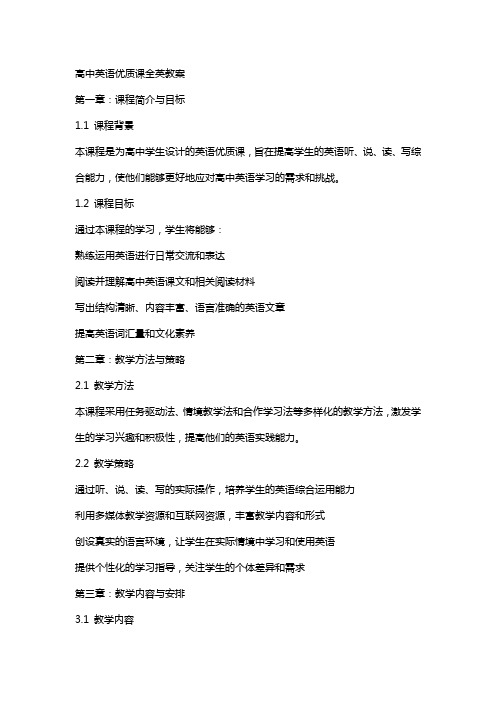
高中英语优质课全英教案第一章:课程简介与目标1.1 课程背景本课程是为高中学生设计的英语优质课,旨在提高学生的英语听、说、读、写综合能力,使他们能够更好地应对高中英语学习的需求和挑战。
1.2 课程目标通过本课程的学习,学生将能够:熟练运用英语进行日常交流和表达阅读并理解高中英语课文和相关阅读材料写出结构清晰、内容丰富、语言准确的英语文章提高英语词汇量和文化素养第二章:教学方法与策略2.1 教学方法本课程采用任务驱动法、情境教学法和合作学习法等多样化的教学方法,激发学生的学习兴趣和积极性,提高他们的英语实践能力。
2.2 教学策略通过听、说、读、写的实际操作,培养学生的英语综合运用能力利用多媒体教学资源和互联网资源,丰富教学内容和形式创设真实的语言环境,让学生在实际情境中学习和使用英语提供个性化的学习指导,关注学生的个体差异和需求第三章:教学内容与安排3.1 教学内容本课程的教学内容包括:基础英语语法和词汇知识高中英语课文和相关阅读材料日常英语口语表达和交流技巧英语写作技巧和策略3.2 教学安排每个单元包括课文阅读、语法知识讲解、口语练习和写作训练每周安排一次课堂教学,每次课时长为45分钟每个单元结束后进行一次小测验,以检验学生的学习效果第四章:教学评价与反馈4.1 教学评价本课程采用形成性评价和终结性评价相结合的方式进行教学评价。
4.2 评价方法平时作业和课堂表现占总评的30%单元测试和期末考试占总评的70%4.3 反馈机制教师应及时给予学生反馈,指出他们的优点和不足之处,并提供改进的建议学生之间应互相交流和反馈,共同提高英语水平第五章:教学资源与工具5.1 教学资源本课程所需的教学资源包括:高中英语课本和相关阅读材料多媒体教学课件和视频材料英语学习网站和在线资源5.2 教学工具使用投影仪和计算机等多媒体设备进行教学利用互联网和在线学习平台,提供更多的学习资源和练习机会第六章:教学计划6.1 课程进度计划本课程共计36课时,每课时45分钟。
高中英语教学全英案例

中学英语教学案例一.教材分析本单元以A healthy life为话题,通过谈论人们最关切的健康问题,使学生相识到吸烟、喝酒、吸毒、不良饮食等对健康的危害,了解吸烟的危害及怎样戒烟;通过阅读一篇有关艾滋病的宣扬文章了解一些艾滋病的常识及如何预防艾滋病;并学会如何就健康问题给别人供应一些建议;功能句式要求学生学会如何表达聚会中的礼仪和禁忌。
通过单元学习,要求学生意识到健康的重要性,养成良好的生活习惯,并学会帮助别人解决一些健康问题。
1.1 Warming Up列举了一些年轻人所关切的健康问题,由此引出单元话题。
要求学生列举出更多类似的健康问题,然后在小组和班级范围内进行比较,说出哪个问题是最重要的,并列举出5个有关这个问题人们应当了解的学问。
1.2 Pre-reading要求学生探讨5个与吸烟有关的问题,为后面的Reading做铺垫。
1.3 Reading是一封爷爷写给James的建议信,信中谈到了吸烟为什么会上瘾、吸烟对健康的危害并附上了一篇如何戒烟的文章来帮助James戒烟。
1.4 Comprehending要求学生探讨几个与Reading内容有关的问题,并依据Reading的内容完成表格。
另外还要求学生用自己的语言简要概述一下advice on how to stop smoking。
1.5 Learning about Language包括两部分:Discovering useful words and expressions是两个关于Reading中的一些词汇的练习;Discovering useful structures 是关于it structure的用法介绍和练习。
1.6 Using Language是一篇关于HIV / AIDS的宣扬材料,介绍了一些有关艾滋病病毒和艾滋病的基本学问以及在生活中如何进行预防。
要求学生能推断一些相关陈述的正误。
1.7 Listening是Tina和Sara之间的一段对话,要求学生能听出一些关键词并完成句子。
高中英语教案(优秀8篇)

高中英语教案(优秀8篇)高中英语教学设计篇一单元整体设计思路第一课时:阅读课Warming up; Pre-reading; Reading; Comprehending (pp. 1-2)第二课时:语法课Discovering useful structures (p. 4); Using structures (p. 43)第三课时:阅读与听说课Reading and listening; Speaking (pp. 5-6)第四课时:词汇课Discovering useful words and expressions (p. 3); Using words and expressions (p. 42)第五课时:听说课Listening; Talking (p. 41)第六课时:读写课Reading and writing (p. 7)第七课时:单元评价课Self-test and self-evaluation; Summary第一课时阅读课一、教学内容Warming up; Pre-reading; Reading; Comprehending (pp. 1-2)二、教学目标在本节课结束时,学生能够了解文化遗产的基本概念、本质特点以及基本类型。
通过找读(scanning)关键词、略读(skimming) 和精读(careful reading),了解有关琥珀屋的故事。
用归类法学习词汇。
用自己的话复述琥珀屋的故事。
运用本课时学习的内容和自己已有的知识讨论相关话题。
三、教学步骤步骤一热身1.请学生看学生用书p. 1或者PPT中的图片,两人一组讨论三个问题。
教师请几组学生回答问题,然后综合大家的看法总结出文化遗产的定义。
2. 请学生说出一些中外文化遗产的名称,教师写在黑板上。
可以采取小组竞赛的形式,比一比看哪组说得多、说得正确。
注:问题中出现了五个生词。
rare, valuable和survive很难根据上下文猜出词义,教师可以布置学生课前查字典自学其词义,用法可以留到词汇课处理。
高中英语教案英文4篇
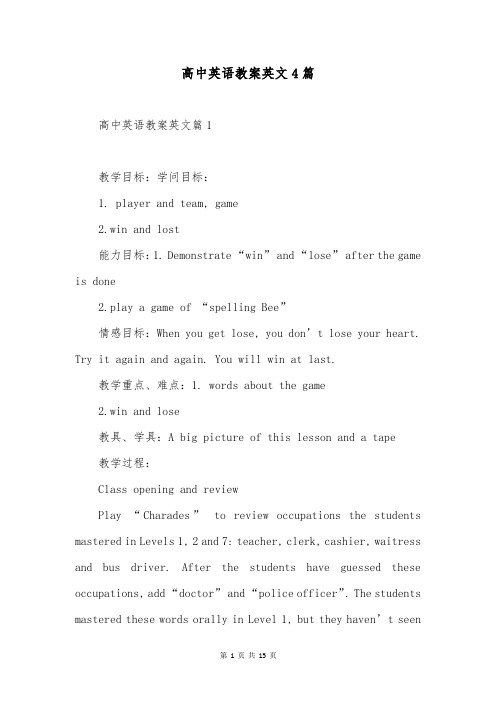
高中英语教案英文4篇高中英语教案英文篇1教学目标:学问目标:1. player and team, game2.win and lost能力目标:1. Demonstrate “win” and “lose” after the game is done2.play a game of “spelling Bee”情感目标:When you get lose, you don’t lose your heart. Try it again and again. You will win at last.教学重点、难点:1. words about the game2.win and lose教具、学具:A big picture of this lesson and a tape教学过程:Class opening and reviewPlay “Charades”to review occupations the students mastered in Levels 1, 2 and 7: teacher, clerk, cashier, waitress and bus driver. After the students have guessed these occupations, add “doctor” and “police officer”. The students mastered these words orally in Level 1, but they haven’t seenthem for a long time. Whisper the translation for these occupations to the students acting them out, and help the class guess the occupations with lots of prompts and encouragement. You can, for example, draw blanks on the blackboard and slowly write in the letters as you soundout more and more of each occupation.IntroduceDemonstrate “player”“team”“game” with six volunteers and a game of “spelling bee” divide the volunteers into two teams of three. Give player a sheet of coloured paper to hold, the same colour for each team.Demonstrate “win” and “lose” after the game is done. Point to the teams and as you say “You win/lose”Use the student bookPause after Number 1 in the student book.Review the story so far. Li Ming and Jenny have been learning about sports. Look at the pictures in the student book. What are they doing now?Note some of the idiom in this lesson: Bob plays basketball “for fun” Jenny and Li Ming “jump up and down” Li Ming asks Jenny “What’s the score?” What do the students think these phrases mean?PracticeDivide the class into small groups. In each group. Some students pretend that they want to learn a game that the other students know how to learn a game that you play in class.Do the activity bookClass closing高中英语教案英文篇2教学目标学问与技能(1)熟练把握下列词汇:rules, arrive, late, hall, dinning hall, listen, , fight, sorry outside,wear, important, bring, uniform, quiet(2)熟练把握下列短语:dining hall, arrive late for school, (be) on time, listen to music break the rules, in class, be/ keep quiet, a lot of, bring …to…,wear a hat, have to, music players(3)把握下列句型:1. Dont eat in class.2. You must be on time.3. Eat in the dining hall.4. 正确使用情态动词can, can’t——Can we wear a hat in school?——Yes, we can./No, we can’t.5. 能正确使用have to 和 must 谈论规章制度We must be on time/ We also have to be quiet in the library.教学重难点重点:1) 确定祈使句是省略掉主语的原形动词开头;2) 否定祈使句则是在确定祈使句前加上“don’t”。
高中英语优秀教学教案(通用5篇)
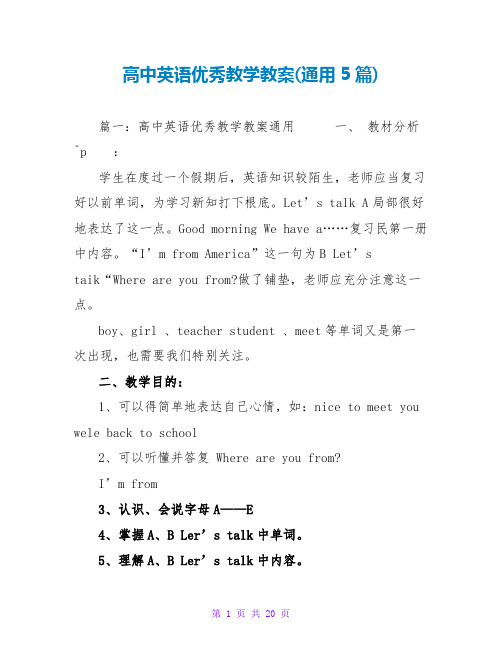
高中英语优秀教学教案(通用5篇)篇一:高中英语优秀教学教案通用一、教材分析^p :学生在度过一个假期后,英语知识较陌生,老师应当复习好以前单词,为学习新知打下根底。
Let’s talk A局部很好地表达了这一点。
Good morning We have a……复习民第一册中内容。
“I’m from America”这一句为B Let’staik“Where are you from?做了铺垫,老师应充分注意这一点。
boy、girl 、teacher student 、meet等单词又是第一次出现,也需要我们特别关注。
二、教学目的:1、可以得简单地表达自己心情,如:nice to meet you wele back to school2、可以听懂并答复 Where are you from?I’m from3、认识、会说字母A——E4、掌握A、B Ler’s talk中单词。
5、理解A、B Ler’s talk中内容。
三、教学重、难点:可以听懂并答复 Where are you from?掌握A、B Ler’s talk中单词。
理解A、B Ler’s tal k中内容。
四、课时安排第一课时 A lLet’s talk Let’s learn B Let’s sing第二课时 A Let’s practise Let’s play Let’schant第三课时 B lLet’s talk Let’s learn第四课时BLet’ssay Let’spractise第五课时 B Let’s Let’s第六课时 C story time篇二:高中英语优秀教学教案通用教学目的1、引导学生通过上下文理解生词的含义:anecdote, annual, witness, acmodation, shore, yell, pack, flee, drag, depth, lip, tongue, abandon, relationship, help out2、帮助学生掌握文中一些描绘事物和情景的生动手法,从而体会作者的思想情感,把握文章的精华。
高中英语优秀教案(优秀7篇)
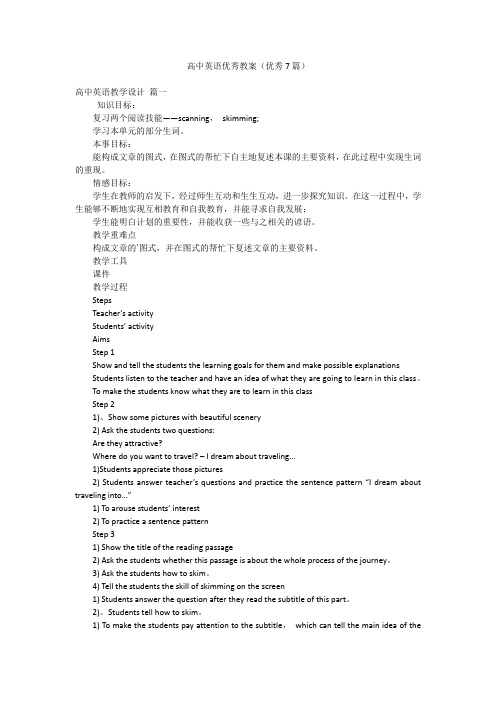
高中英语优秀教案(优秀7篇)高中英语教学设计篇一知识目标:复习两个阅读技能——scanning,skimming;学习本单元的部分生词。
本事目标:能构成文章的图式,在图式的帮忙下自主地复述本课的主要资料,在此过程中实现生词的重现。
情感目标:学生在教师的启发下,经过师生互动和生生互动,进一步探究知识。
在这一过程中,学生能够不断地实现互相教育和自我教育,并能寻求自我发展;学生能明白计划的重要性,并能收获一些与之相关的谚语。
教学重难点构成文章的`图式,并在图式的帮忙下复述文章的主要资料。
教学工具课件教学过程StepsTeacher’s activityStudents’ activityAimsStep 1Show and tell the students the learning goals for them and make possible explanationsStudents listen to the teacher and have an idea of what they are going to learn in this class。
To make the students know what they are to learn in this classStep 21)、Show some pictures with beautiful scenery2) Ask the students two questions:Are they attractive?Where do you want to travel? – I dream about traveling…1)Students appreciate those pictures2) Students answer teacher’s questions and practice the sentence pattern “I dream about traveling into…”1) To arouse students’ interest2) To practice a sentence patternStep 31) Show the title of the reading passage2) Ask the students whether this passage is about the whole process of the journey。
高中英语优质课全英教案
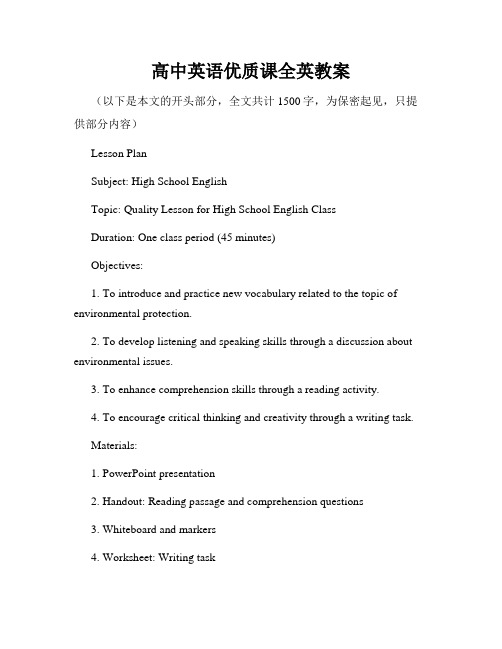
高中英语优质课全英教案(以下是本文的开头部分,全文共计1500字,为保密起见,只提供部分内容)Lesson PlanSubject: High School EnglishTopic: Quality Lesson for High School English ClassDuration: One class period (45 minutes)Objectives:1. To introduce and practice new vocabulary related to the topic of environmental protection.2. To develop listening and speaking skills through a discussion about environmental issues.3. To enhance comprehension skills through a reading activity.4. To encourage critical thinking and creativity through a writing task.Materials:1. PowerPoint presentation2. Handout: Reading passage and comprehension questions3. Whiteboard and markers4. Worksheet: Writing taskProcedure:Warm-up (5 minutes):Begin the lesson by displaying a series of images related to environmental problems on the PowerPoint presentation, such as pollution, deforestation, and climate change. Ask students to discuss in pairs or small groups what they see in the pictures and their thoughts about these issues.Vocabulary Introduction (10 minutes):Introduce the new vocabulary related to the topic of environmental protection, using the PowerPoint presentation. Present each word along with its meaning, pronunciation, and an example sentence. Encourage students to repeat the words after you and ask if they have any questions. Write the words and their definitions on the whiteboard for reference.Listening and Speaking Activity (15 minutes):Divide the class into pairs and distribute a set of discussion questions related to environmental issues. Ask students to discuss the questions with their partners, taking turns to share their ideas and opinions. Monitor their discussions and provide guidance or assistance when necessary. After the discussion, ask a few pairs to share their thoughts with the whole class.Reading Comprehension (10 minutes):Hand out the reading passage and comprehension questions to each student. Instruct them to read the passage silently and answer the questions individually. Allow them enough time to finish before discussing theanswers as a class. Encourage students to share their reasoning for each answer and promote a discussion about different perspectives on the topic.Writing Task (15 minutes):Distribute the writing task worksheet and instruct students to express their views on environmental protection in the form of a short essay. Provide them with a writing prompt to guide their thoughts, such as "What actions can individuals take to protect the environment?" Encourage students to include examples and reasons to support their ideas. Monitor their progress and provide feedback as they complete the task.Closure (5 minutes):Wrap up the lesson by briefly summarizing the main points covered in class. Ask students to reflect on what they have learned about environmental issues and how they can contribute to protecting the environment in their daily lives. Thank students for their participation and effort throughout the lesson.Assessment:Throughout the lesson, observe students' participation in the discussions, their ability to comprehend the reading passage, and the quality of their written essays. Use a rubric to evaluate their performance based on the objectives of the lesson.Homework:Assign students to conduct further research on an environmental issue of their choice and prepare a short presentation to share with the class in thenext lesson. Encourage them to include relevant facts, statistics, and possible solutions to the problem.Note: This lesson plan can be adapted and used for different proficiency levels by adjusting the complexity of the vocabulary and the depth of the writing task. It is crucial to create a positive and inclusive classroom environment where students feel comfortable expressing their opinions and ideas.。
(完整版)高中英语优质课全英教案

Introduce a PlaceFrom Module2 Unit4 Communication WorkshopI。
Teaching aimsAt the end of this lesson, students will1.be very interested in writing an article to introduce a place。
2.be able to use suitable person, tense, layout, sentence structures and linking words to introduce a place 。
3.be proud of our capital Beijing and our hometown Jiaozuo and love them.II。
Teaching key points and difficult points1。
Teacher leads students to understand and master the layout, sentence structures and linking words effectively.2。
Teacher leads students to master the way to use advanced and various sentence structures.III. Teaching and learning methodsProcess—focused writing approach, Group work, Cooperative learning.IV。
Teaching procedure1.Teacher arouses students’ interests by showing some photos of some famous cities in the world, and singing the song, “Welcome to Beijing".2.Teacher shows the sample article of Beijing to students. This article serves as language input before writing。
- 1、下载文档前请自行甄别文档内容的完整性,平台不提供额外的编辑、内容补充、找答案等附加服务。
- 2、"仅部分预览"的文档,不可在线预览部分如存在完整性等问题,可反馈申请退款(可完整预览的文档不适用该条件!)。
- 3、如文档侵犯您的权益,请联系客服反馈,我们会尽快为您处理(人工客服工作时间:9:00-18:30)。
Introduce a Place
From Module2 Unit4 Communication Workshop
I. Teaching aims
At the end of this lesson, students will
1.be very interested in writing an article to introduce a place.
2.be able to use suitable person, tense, layout, sentence structures and linking words to introduce a place .
3.be proud of our capital Beijing and our hometown Jiaozuo and love them.
II. Teaching key points and difficult points
1. Teacher leads students to understand and master the layout, sentence structures and linking words effectively.
2. Teacher leads students to master the way to use advanced and various sentence structures.
III. Teaching and learning methods
Process-focused writing approach, Group work, Cooperative learning.
IV. Teaching procedure
1.Teacher arouses students’ interests by showing some photos of some famous cities in the world, and singing the song, “Welcome to Beijing”.
2.Teacher shows the sample article of Beijing to students. This article serves as
language input before writing.
3. Teacher asks students questions to lead them to understand and master the layout, sentence structures and linking words effectively.
e.g. “How many paragraph s are there in the article?”
Answer: (1. Introduction. 2. Things to see. 3. Things to do. 4. Ending words.) “What factors are in cluded in the first paragraph?”
Answer: (General description, Location, Area, Population, History, Climate and
Temperature.).
“Can you find and circle the beautiful and advanced sentences in the article?”Answer:
(Location : 1. …is located in … 2. …lies in….
Area: 1. …covers an area of…2. ...is the second/ third/rgest city in the world as regards area. etc.)
4. Students work in groups and cooperate with each other to answer these questions.
5. Teacher introduces the writing task “write an article to introduce Jiaozuo.
6. Teacher divides students into groups of six and arouses them to express the photos of Jiaozuo in best possible ways according to the sentence structures in the article of Beijing. Meanwhile, teacher encourages students to join simple sentences together with linking words, relative pronouns,present participles, etc. to form more advanced and more various sentence structures.
7. Students write the first drafts by themselves.
8. Teacher stimulates students to check and correct their own drafts; meanwhile, teacher provides the standards of checking and correcting. For example, the content, the layout, the language, the linking words, the handwriting, the tense and person, the grammar and the spelling.
9. Teacher divides students into groups of six and arouses them to check and correct their partners’ articles. Teacher provides the standards of checking and correcting again.
10. Teacher chooses two typical articles to examine before class; students learn how to check fully and effectively.
10. Teacher help the students to summarize some typical and common mistakes among students’ articles, and correct and analyze them.
12. Homework. Polish the first draft and rewrite it.
V. After-class reflection(教后反思)
1. By singing a song to lead in, students are deeply aroused to read the sample article of Beijing, but my singing is not professional and perfect.
2. The article is well designed with many good sentence structures and linking words, students can understand them by answering the questions intended for them, but the time spared for them is too limited, and they can’t fully master a nd practice them.
3. The time given students to write is 10 minutes, which proves relatively short and limited. I should have given them more time to write the article better.
4. The time for students to check is only 3 minutes, which proves to be too short. The checking procedure is very important in writing practice, so teachers should place more emphasis on it.。
